Previewing Silicon Motion SM2260 NVMe Controller With 3D MLC NAND (512GB)
by Billy Tallis on February 17, 2017 9:00 AM ESTAnandTech Storage Bench - The Destroyer
The Destroyer is an extremely long test replicating the access patterns of very IO-intensive desktop usage. A detailed breakdown can be found in this article. Like real-world usage and unlike our Iometer tests, the drives do get the occasional break that allows for some background garbage collection and flushing caches, but those idle times are limited to 25ms so that it doesn't take all week to run the test.
We quantify performance on this test by reporting the drive's average data throughput, a few data points about its latency, and the total energy used by the drive over the course of the test.
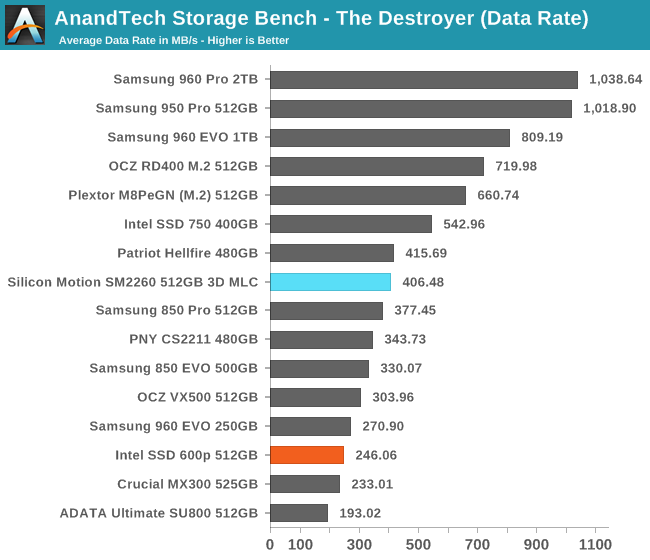
The SM2260 sample's average data rate on The Destroyer is just a hair slower than the Phison-based Patriot Hellfire. This makes the SM2260 sample the slowest NVMe SSD using MLC NAND, but it's still faster than any SATA SSD.
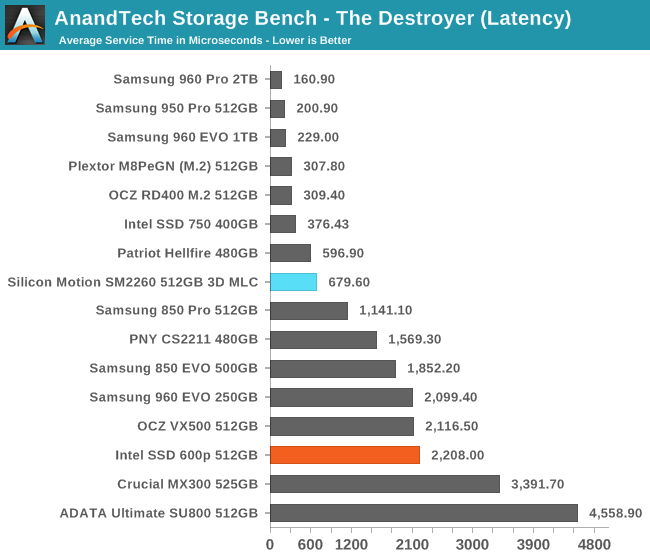
The SM2260 sample's average service time during The Destroyer is again in last place for NVMe/MLC SSDs, but the SATA SSDs and some of the TLC-based NVMe SSDs are trailing behind by a wide margin.
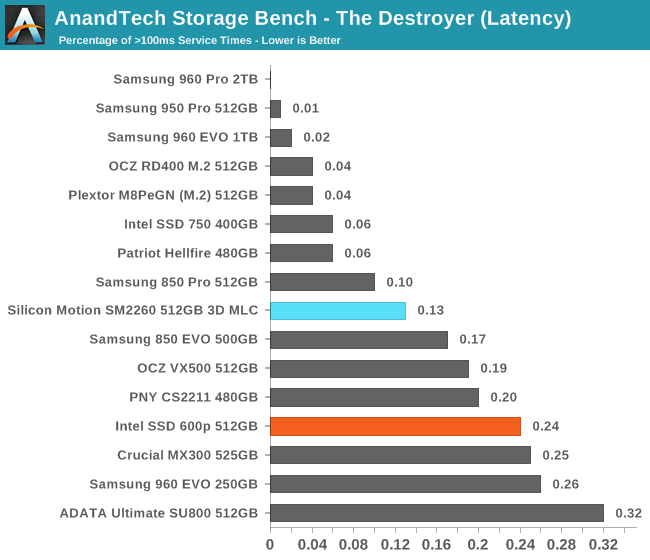
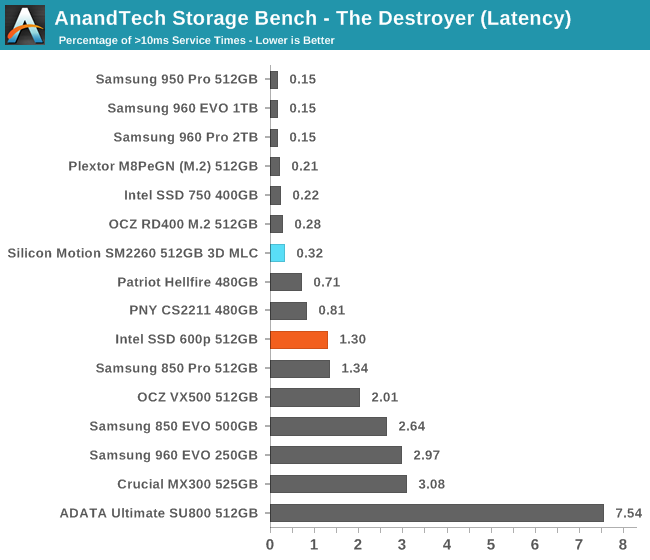
The SM2260 sample is not great at avoiding high-latency outliers above 100ms and ranks behind the Samsung 850 PRO. At the 10ms threshold, the SM2260 sample performs quite well with big advantage over the Patriot Hellfire, the Intel SSD 600p and the SATA SSDs.
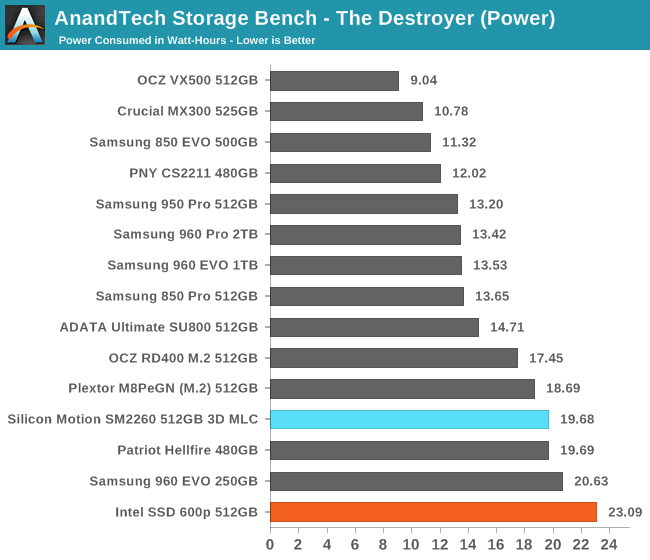
The SM2260 sample with 3D MLC improves significantly over the poor power efficiency of the TLC-based Intel SSD 600p, but it still ranks poorly overall. It is tied with the Phison E7-based Patriot Hellfire.










27 Comments
View All Comments
BrokenCrayons - Friday, February 17, 2017 - link
It seems like power consumption and consistency are both problems. Consistency can probably be addressed through tuning and optimization of firmware, but power consumption is probably something that can't be fine-tuned away. NVMe drives aren't as power friendly as SATA, but the inefficiencies of some recently reviewed SSDs here on Ananatech certainly seems to throw a spotlight on the problem. Between that and thermal throttling, the NVMe storage picture isn't very rosy just yet.KAlmquist - Friday, February 17, 2017 - link
Even with 25% overprovisioning, I see a 1 second interval at the 3350 mark where the IOP's fall to zero. Fortunately, the performance consistency of this SSD seems more in line with its competitors on the trace-based benchmarks (The Destroyer, etc.).The sequential read performance at queue depth 1 is lower than that of budget SATA SSD's like the MX300. At higher queue depths, the sequential reads are faster than anything a SATA SSD can manage, but queue depths of 1 are not uncommon in a desktop environment.
vladx - Saturday, February 18, 2017 - link
Now we can see why Micron cancelled its' NVMe SSD using the SM2260, it's simply not competive.Drumsticks - Saturday, February 18, 2017 - link
So what's a good roundup conclusion on the current state of NVMe drives? If we want to pick one up this year, where does the performance go from "bad for NVMe" to "not Samsung but still pretty good!"? Plextor?vladx - Saturday, February 18, 2017 - link
Indeed Plextor M8Pe seems to be the best buy option at the moment in the NVMe space.Drumsticks - Saturday, February 18, 2017 - link
That's what I was thinking. $220/$240 for the 500GB model right now. So much more than it used to be. Do we have any news on whether anything constraining nand supply will be alleviating any time soon?vladx - Saturday, February 18, 2017 - link
The supply problems most likely will be gone after Chinese companies will flood this market in 2018. But it could happen sooner than that depending on how fast will Toshiba/Western Digital will be rolling up their own 3D NAND supply.Chaser - Saturday, February 18, 2017 - link
"and the Plextor M8Pe is very slightly faster."AbRASiON - Sunday, February 19, 2017 - link
If this is CHEAPER than an MX300 it's an incredibly good bargain. The MX300's are really really well priced. I'd consider it if it's dead, dead cheap.The 960 Evo / Pro is a joke, sure it's fast but in real world usage, it's ridiculously expensive.
Make the 1TB version of this for $250 US or less and I'm very much in. (I doubt it will though)
StrangerGuy - Sunday, February 19, 2017 - link
I know right, Techreport tested the 960 Evo/Pro are both so close to yesteryears SATA3 SSDs in real-world load times that they are easily within the margin of error. I don't care about how NVMe is able to reach uber fast raw speeds that has zero use to me or to 99% of the people out there, but a hypothetical SSD with half the raw transfer speed of current SATA3 SSDs for 2x the capacity per dollar? That's a real bargain.